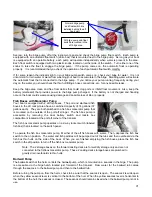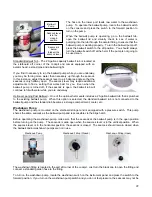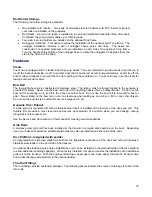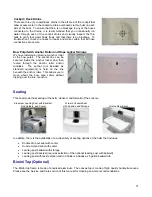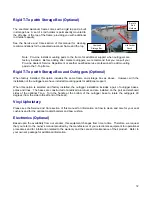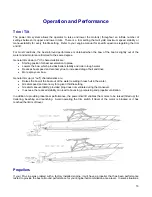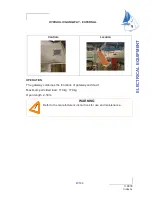
19
Note: For boats rigged with analog gauges, the gauge configuration may include individual
gauges for the temperature, trim, volts and fuel gauges or a multifunction gauge that includes
multiple functions. For boats rigged with digital gauges, the temperature, trim, volts and fuel
gauges are incorporated into the tachometer gauge.
Tachometer - To ensure the tachometer (tach) is working properly, simply turn the ignition key on and start the
engine. While the engine is idling, the tach should be reading in the proper RPM range recommended for the
engine. Your engine manual will indicate the appropriate RPM range. When you are running at wide-open
throttle, the tach should read near the top end of the recommended RPM range.
If the RPM gauge is reading correctly and the engine throttle settings are correct, the tachometer is operating
properly. If the tachometer is not reading correctly, refer to the manual provided by the manufacturer of the gauge
(included in your owner’s package).
Speedometer - To ensure that the speedometer (Speedo) is working properly, get the boat on a planing speed
and check to see if the gauge is reading at the approximate running speed at which the boat is traveling.
Note: The speed-reading on the Speedo may vary a few mph from the actual speed that the boat
is traveling. Either a GPS or a radar gun can check the running speed.
Trim - To ensure the trim gauges/indicators are working properly, start by making sure the engine is trimmed all
the way down. Locate the trim gauge on the instrument panel and check to see if the level on the trim gauge is in
the full down position. As you trim the engine up, watch the trim gauge and ensure that it coincides with the
actual trim of the engine. When you are finished trimming the engine all the way up, the level on the trim gauge
should read in the full up position.
Volts - To system check the volt gauge, turn the ignition key on and turn on the engine. With the engine running,
check the reading on the volt gauge. It should be reading between 12 and 14.5 volts. This reading ensures that
the charging system and the volt gauge are working properly.
Fuel - The fuel gauge reads the amount of fuel remaining in the tank. To check the fuel gauge, place a known
amount of fuel into the fuel fill and fill the tank. Turn the ignition key on and the fuel gauge should read the
approximate amount of fuel in the tank.
For example: If the fuel tank holds 160 gallons of fuel and you pumped 40 gallons of fuel into the
tank, the fuel gauge should read approximately ¼ of a tank. This ensures that the fuel gauge and
the fuel sender are working properly.
If the fuel gauge is not reading correctly, we recommend that you have the fuel sender checked by a qualified
service professional before considering changing out the gauge. For more information, please refer to the
Fuel/Oil Systems section of this manual.
For specific information related to your gauges, refer to the materials in your owner’s package that was provided
by the gauge manufacturer.
Fresh Water System
Note: There must be fresh water in the fresh water tank in order for the pump to operate
properly. Operating the pump with an empty tank could cause serious damage to the pump.
Fresh Water Pump
The fresh water pump is located on top of the port side stringer. It is accessible via the bilge hatch and/or by
removing the compartment that houses the tackle box and the optional dual battery switches that are installed
behind the transom door. Depressing the fresh water switch located on the switch panel to the forward position
provides power to the fresh water pump.
Summary of Contents for 2009 26 Super Sport
Page 2: ...ii...

















